#Harry S. Truman Library & Museum
Text


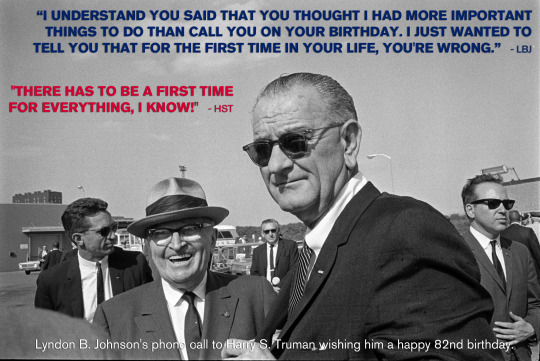
On May 8th of each year of Lyndon B. Johnson's Presidency, LBJ made sure that he made a phone call to the house at 219 North Delaware Street in Independence, Missouri, where former President Harry S. Truman was living in retirement and celebrating another birthday. Truman would always insist that President Johnson had far more important things to do with his time than call a retired old Missouri politician, and LBJ would insist that he couldn't think of anything more important to do with his time than take a moment to thank Harry Truman for his service to the country.
Truman celebrated 88 birthdays before he died on December 26, 1972, nearly four years after Johnson had left the White House and retired to his ranch in Texas. At the time of Truman's death, LBJ was also a very sick man, but he refused to listen to doctors who urged him not to make the trip to Truman's funeral in Missouri.

When an ailing Lyndon Johnson bowed his head while paying respect before Truman's casket on December 27, 1972, it was the last time many Americans saw LBJ alive. Lyndon Johnson died less than a month later, on January 22, 1973, and was buried in the family graveyard at the LBJ Ranch in Texas almost one month to the day after he stood next to Harry S. Truman's flag-draped casket in Missouri.
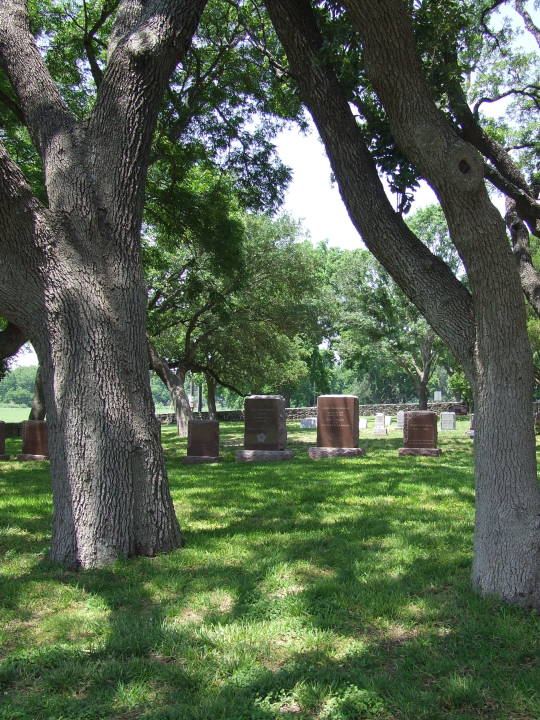
#History#Presidents#Harry S. Truman#Lyndon B. Johnson#LBJ#President Truman#President Johnson#Presidential Relationships#Presidential Friendships#Presidential History#Death of Harry S. Truman#Death of Lyndon B. Johnson#Truman's Birthday#Funeral of Harry S. Truman#Funeral of Lyndon B. Johnson#Truman Library#Harry S. Truman Library & Museum#LBJ Library#LBJ Presidential Library#LBJ Ranch#Presidential Funerals#Presidential Deaths#Political History#Politics
64 notes
·
View notes
Text
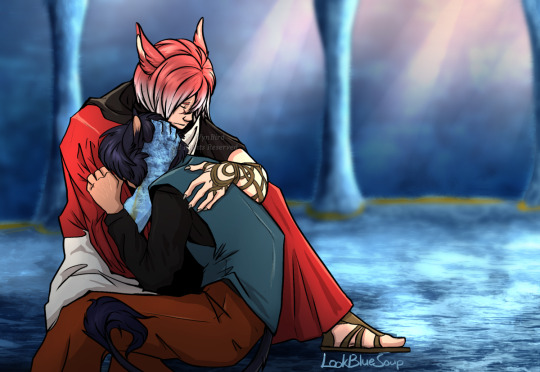
Sometimes after saving the world against impossible odds and surviving certain death by sheer force of will you'll just have a complete breakdown at an inconvenient moment, and it's times like those you need an emotional support wizard to hold you while you cry on his very beautiful crystal floor.
#ive had this as a WIP for... over a year now i think and was suddenly DETERMINED to finish it today#Reference: Al Chang's Crying Soldier photo - 1950 - Harry S Truman Library/Museum - Public Domain#ffxiv#ff14#graha tia#wolgraha#crystal exarch#art#my art#personal fav#shadowbringers spoilers
180 notes
·
View notes
Text
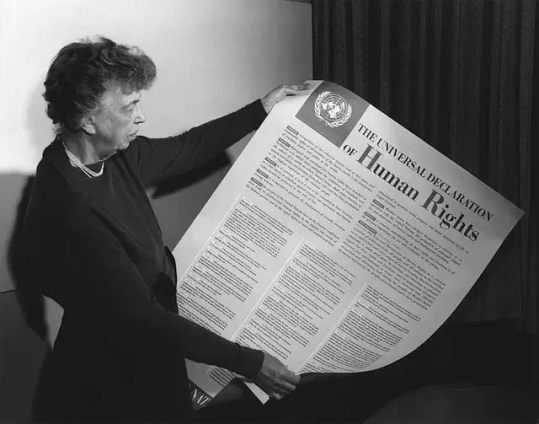
[Eleanor Roosevelt with the Universal Declaration of Human Rights, courtesy of the FDR Presidential Library & Museum, via Wikipedia Commons]
* * *
LETTERS FROM AN AMERICAN
December 10, 2023
HEATHER COX RICHARDSON
Seventy-five years ago today, on December 10, 1948, the United Nations General Assembly announced the Universal Declaration of Human Rights (UDHR).
At a time when the world was still reeling from the death and destruction of World War II, the Soviet Union was blockading Berlin, Italy and France were convulsed with communist-backed labor agitation, Arabs opposed the new state of Israel, communists and nationalists battled in China, and segregationists in the U.S. were forming their own political party to stop the government from protecting civil rights for Black Americans, the member countries of the United Nations nonetheless came together to adopt a landmark document: a common standard of fundamental rights for all human beings.
The United Nations itself was only three years old, having been formed in 1945 as a key part of an international order based on rules on which nations agreed, rather than the idea that might makes right, which had twice in just over twenty years brought wars that involved the globe. In early 1946 the United Nations Economic and Social Council organized a nine-person commission on human rights to set up the mission of a permanent Human Rights Commission. Unlike other U.N. commissions, though, the selection of its members would be based not on their national affiliations but on their personal merit.
President Harry S. Truman had appointed Eleanor Roosevelt, widow of former president Franklin Delano Roosevelt and much beloved defender of human rights in the United States, as a delegate to the United Nations. In turn, U.N. Secretary-General Trygve Lie from Norway put her on the commission to develop a plan for the formal human rights commission. That first commission, in turn, asked Roosevelt to take the chair.
“[T]he free peoples” and “all of the people liberated from slavery, put in you their confidence and their hope, so that everywhere the authority of these rights, respect of which is the essential condition of the dignity of the person, be respected,” a U.N. official told the commission at its first meeting on April 29, 1946. Their work would establish the United Nations as a centerpiece of the postwar rules-based international order.
The U.N. official noted that the commission must figure out how to define the violation of human rights not only internationally but also within a nation, and must suggest how to protect “the rights of man all over the world.” If a procedure for identifying and addressing violations “had existed a few years ago,” he said, “the human community would have been able to stop those who started the war at the moment when they were still weak and the world catastrophe would have been avoided.”
Drafted over the next two years, the final document began with a preamble explaining that a UDHR was necessary because “recognition of the inherent dignity and of the equal and inalienable rights of all members of the human family is the foundation of freedom, justice and peace in the world,” and because “disregard and contempt for human rights have resulted in barbarous acts which have outraged the conscience of mankind.” Because “the advent of a world in which human beings shall enjoy freedom of speech and belief and freedom from fear and want has been proclaimed as the highest aspiration of the common people,” the preamble said, “human rights should be protected by the rule of law.”
The thirty articles that followed established that “[a]ll human beings are born free and equal in dignity and rights…without distinction of any kind, such as race, colour, sex, language, religion, political or other opinion, national or social origin, property, birth or other status” and regardless “of the political, jurisdictional or international status of the country or territory to which a person belongs.”
Those rights included freedom from slavery, torture, degrading punishment, arbitrary arrest, exile, and “arbitrary interference with…privacy, family, home or correspondence, [and] attacks upon…honour and reputation.”
They included the right to equality before the law and to a fair trial, the right to travel both within a country and outside of it, the right to marry and to establish a family, the right to own property.
They included the “right to freedom of thought, conscience and religion,” “freedom of opinion and expression,” peaceful assembly, the right to participate in government, either “directly or through freely chosen representatives,” the right of equal access to public service. After all, the UDHR noted, the authority of government rests on the will of the people, “expressed in periodic and genuine elections which shall be by universal and equal suffrage.”
They included the right to choose how and where to work, the right to equal pay for equal work, the right to unionize, and the right to fair pay that ensures “an existence worthy of human dignity.”
They included “the right to a standard of living adequate for…health and well-being…, including food, clothing, housing and medical care and necessary social services, and the right to security in the event of unemployment, sickness, disability, widowhood, old age or other lack of livelihood in circumstances beyond [one’s] control.”
They included the right to free education that develops students fully and strengthens “respect for human rights and fundamental freedoms.” Education “shall promote understanding, tolerance and friendship among all nations, racial or religious groups, and shall further the activities of the United Nations for the maintenance of peace.”
They included the right to participate in art and science.
They included the right to live in the sort of society in which the rights and freedoms outlined in the UDHR could be realized. And, the document concluded, “Nothing in this Declaration may be interpreted as implying for any State, group or person any right to engage in any activity or to perform any act aimed at the destruction of any of the rights and freedoms set forth herein.”
Although eight countries abstained from the UDHR—six countries from the Soviet bloc, South Africa, and Saudi Arabia—no country voted against it, making the vote unanimous. The declaration was not a treaty and was not legally binding; it was a declaration of principles.
Since then, though, the UDHR has become the foundation of international human rights law. More than eighty international treaties and declarations, along with regional human rights conventions, domestic human rights bills, and constitutional provisions, make up a legally binding system to protect human rights. All of the members of the United Nations have ratified at least one of the major international human rights treaties, and four out of five have ratified four or more.
The UDHR is a vital part of the rules-based order that restrains leaders from human rights abuses, giving victims a language and a set of principles to condemn mistreatment, language and principles that were unimaginable before 1948.
But the UDHR remains aspirational. “As we look at the first 75 years of the UDHR,” Secretary of State Antony Blinken said today, “we recognize what we’ve accomplished in this time, but also know that much work remains. Too often, authorities fail to protect or—worse—trample on human rights and fundamental freedoms, often in the name of security or to maintain their grip on power. Whether arresting and wrongfully detaining journalists and dissidents, restricting an individual’s freedom of religion or belief, or committing atrocities and acts of genocide, violations and abuses of human rights undermine progress made in support of the UDHR. In the face of these actions, we must press for greater human rights protection and promote accountability whenever we see violations or abuses of human rights and fundamental freedoms.
“On its 75th anniversary, the UDHR must continue to be our guiding light as we strive to create the world in which we want to live. Its message is as importa
LETTERS FROM AN AMERICAN
HEATHER COX RICHARDSON
#Letters From An American#Heather Cox Richardson#United Nations#UDHR#Universal Declaration of Human Rights (UDHR)#history#human rights#Eleanor Roosevelt
18 notes
·
View notes
Text
Recently, White House mythmakers have claimed that President Harry S. Truman began the tradition of “pardoning” a turkey. However, the Truman Library & Museum disputes the notion that he was the first to do so. The focus on Truman stems from his being the first president to receive a turkey from the Poultry and Egg National Board and the National Turkey Federation. From September to November 1947, announcements of the government encouraging "poultryless Thursdays" grabbed national headlines. Outrage from homemakers, restaurant owners, and the poultry industry was palpable in Washington. This came to a head when the poultry industry pointed out that the upcoming Thanksgiving, Christmas, and New Year’s Day, the three big turkey holidays, happened to fall on Thursday. The effort was deflated in time for Thanksgiving, but not before poultry growers had sent crates of live chickens— "Hens for Harry"— to the White House in protest. The turkey they presented to President Truman that December promoted the poultry industry and established an annual news niche that endures today.
(source) something may be wrong with the american people. why would you send crates of live chickens as protests....what does that. achieve. its free chickens. and also presumably very expensive? will the mail just deliver live chickens?
6 notes
·
View notes
Text
What is meant by the modern term referred to as “POLITICAL CORRECTNESS”..
The definition of “Political Correctness” is found in 4 telegrams at the Truman Library and Museum in Independence, Missouri.
The following are copies of four telegrams between President Harry Truman and Gen Douglas MacArthur on the day before the actual signing of the WWII Surrender Agreement in September 1945.
The contents of those four telegrams below are exactly as received at the end of the war - not a word has been added or deleted!
(1) Tokyo, Japan
0800-September 1,1945
To: President Harry S Truman
From: General D A MacArthur
Tomorrow we meet with those yellow-bellied bastards and sign the Surrender
Documents, any last minute instructions?
(2) Washington, D C
1300-September 1, 1945
To: D A MacArthur
From: H S Truman
Congratulations, job well done, but you must tone down your obvious dislike
of the Japanese when discussing the terms of the surrender with the press, because some of your remarks are fundamentally not politically correct!
(3) Tokyo, Japan
1630-September 1, 1945
To: H S Truman
From: D A MacArthur and C H Nimitz
Wilco Sir, but both Chester and I are somewhat confused, exactly what does
the term politically correct mean?
(4) Washington, D C
2120-September 1, 1945
To: D A MacArthur/C H Nimitz
From: H S Truman
Political Correctness is a doctrine, recently fostered by a delusional, illogical
minority and promoted by a sick mainstream media, which holds forth the
proposition that it is entirely possible to pick up a piece of shit by the clean end!
Now, with special thanks to the Truman Museum and Harry himself, you and I finally have a full understanding of what ‘POLITICAL CORRECTNESS’ really means.
3 notes
·
View notes
Text
Pilgrims from around the world journey to Charlotte, North Carolina. They come to visit the home of Billy Graham. It's a very big deal.
We live in Charlotte. We weren't exactly pilgrims when we went on a senior center sponsored bus trip to the Graham library. As A catholic boy growing up in New York, i was aware of Graham but didn't know what to make of him. There was something very cool about the guy. He had a message about repentance and the transformative power of God's love that I liked. The problem is he wasn't Catholic. I was kinda afraid that if I paid too much attention to him, I would go to hell.
Billy Graham was a renowned American evangelist who played a significant role in shaping American religious life in the 20th century. He was born on November 7, 1918, in Charlotte, North Carolina, and passed away on February 21, 2018.
Graham rose to prominence through his large-scale evangelistic crusades, which he conducted throughout the United States and around the world. He preached a message of salvation through faith in Jesus Christ and aimed to bring people to a personal relationship with God. His charismatic speaking style, combined with his humble demeanor, helped him connect with diverse audiences.
Throughout his career, Graham held numerous evangelistic events, attracting millions of people and making him one of the most recognized religious figures of his time. He presented the Christian message in a straightforward manner, emphasizing the need for repentance and the transformative power of God's love.
Billy Graham also had a significant impact beyond his crusades. He authored several books, including "Peace with God" and "The Journey: Living by Faith in an Uncertain World," which became bestsellers. He also hosted a weekly radio program called "Hour of Decision" and appeared on television, reaching a wide audience with his messages of hope and faith.
Graham's influence extended beyond religious circles. He served as a spiritual advisor to numerous U.S. presidents, from Harry S. Truman to Barack Obama, and provided counsel during times of crisis and national mourning. His commitment to racial integration and his involvement in social issues such as civil rights earned him respect from people across different backgrounds.
Billy Graham's legacy as an evangelist and Christian leader is profound. He preached to millions, counseled world leaders, and left an indelible impact on American Christianity. His commitment to spreading the Gospel and his unwavering faith continue to inspire many people today.
We arrived shortly before the Library opened. A few people with backpacks were waiting outside the gates when we arrived. After passing through the gate, our bus stopped and we departed in front of the Graham family homeplace. We met our tour guide who provided some history. 'The farmhouse at the Billy Graham Library in Charlotte, North Carolina, is not the original Graham family home but a reconstructed replica. The original Graham family home was located on a dairy farm in Charlotte and has been moved several times over the years.The original farmhouse was first relocated to the Graham family's current property in Montreat, North Carolina. Later, it was moved to a different location within Montreat and served as the Graham family retreat center. In 2006, the farmhouse was moved again, this time to its current location at the Billy Graham Library in Charlotte, where it was reconstructed as part of the museum and library complex.The reconstructed farmhouse at the Billy Graham Library provides visitors with a glimpse into the environment and setting where Billy Graham grew up, offering insights into his early life and upbringing. While it is not the original structure, it has been designed to replicate the Graham family home and serves as an important component of the library's exhibits and displays.'
The place is beautiful. It reminded me of the George Eastman house in Rochester with its roped off rooms. I've seen this kind of thing before.
We passed through the house and made our way to the library. Before entering the library, we strolled down a lovely path which led to the grave site of Billy Graham and Ruth Graham The site features a simple stone marker for each of them, with their names and birth and death dates inscribed. Billy's marker reads "Preacher of the Gospel of the Lord Jesus Christ" and includes his birth and death dates. Soft music played in the wooded prayer garden. Within the serenity, I could feel a spiritual breeze in my soul that I had not expected.
When we entered the library, we were greeted by a cow. Of course, when we saw the cow in this location I had to say "Holy Cow" which Lynn didn't appreciate. Lynn asked our guide if the the cow was real. The guide said no. Lynn said it certainly looked real. The guide said then we did our job. We approached the animatronic cow and it began to talk about Billy's childhood during which he rose every morning to milk the cows.
After the cow, we entered the Journey of Faith which is a multi-media presentation of film, photographs, memorabilia and interactive displays accentuating Graham's life, family and evangelist missions all over the globe. Three pieces of memorabilia were particularly impressive; the Presidential Medal of Freedom, an honorary knighthood by Queen Elizabeth II and a Navajo head dress.
The photos include Billy with many US Presidents including Truman, Ike, JFK, LBJ, Nixon, and both Bushes. For me personally, the most impactful photo was of Billy chatting with Muhammad Ali. Muhammad Ali, the legendary boxer, and Billy Graham, the renowned evangelist, first met in the 1960s when Ali was still known as Cassius Clay. Their friendship developed over the years, and they often had discussions about religion and spirituality.
Muhammad Ali and Billy Graham had a notable relationship that was characterized by mutual respect and friendship. Both individuals were prominent figures in their respective fields and shared a deep commitment to their faith.Ali, who converted to Islam and became a member of the Nation of Islam in the 1960s, valued his friendship with Graham despite their theological differences. Graham respected Ali's convictions and supported his religious freedom. He recognized Ali's influence and the impact he had on society both inside and outside the boxing ring.
In the 1970s, Ali and Graham collaborated on several occasions. They participated in a joint television interview in 1977, where they discussed faith, social issues, and the importance of spiritual values. They also worked together on humanitarian efforts, such as raising funds for relief projects in developing countries.
Both Ali and Graham were known for their strong convictions and their ability to connect with people from different backgrounds. They shared a belief in the power of faith and used their platforms to promote unity, peace, and social justice.
Their relationship continued to grow over the years, and Graham was among the prominent figures who eulogized Ali at his memorial service in 2016. He spoke of their friendship and the impact Ali had on his life and the world.
The friendship between Muhammad Ali and Billy Graham exemplified their ability to transcend differences and find common ground in their shared commitment to their faith and their desire to make a positive impact on society.
One of the last stops on the Journey of Faith is a model of the Berlin Wall. In June 1961, just a few months before the construction of the Berlin Wall began, Billy Graham conducted a series of evangelistic meetings in West Berlin. His crusades attracted large crowds, including both East and West Berliners, who were able to freely cross the border at that time. Graham's messages of hope and faith resonated with the people, especially those living in the tense environment of a divided city.
However, during Graham's visit, tensions between East and West Germany were escalating rapidly. The East German government, fearing the influence of Western ideologies, began constructing the Berlin Wall in August 1961 to halt the mass migration of its citizens to West Germany. The wall physically divided families, friends, and communities, and became a symbol of the Cold War. After the wall's construction, Graham continued to express his concern for the people affected by it. In subsequent visits to Germany, he emphasized the need for unity and reconciliation, calling on individuals and governments to work toward peaceful solutions.
During the Cold War era, Graham's messages of faith, hope, and reconciliation resonated with many people living under the shadow of the Berlin Wall. While he did not have a direct role in the wall's history, his visits and teachings served as a reminder of the importance of compassion, forgiveness, and spiritual freedom, even in the face of political divisions.
When we left the Journey, we were offered the opportunity to visit a prayer room where a guide would be happy to pray with us. Once again my Catholic upbringing reared its head. I declined the opportunity.
The Catholic Church's view of Billy Graham has been generally positive, recognizing his efforts in spreading the Gospel and his commitment to promoting Christian faith. While there may have been theological differences between Graham's evangelical Protestant beliefs and Catholic teachings, the Catholic Church acknowledged his impact and respected his dedication to proclaiming Jesus Christ.
Throughout his career, Billy Graham maintained a respectful relationship with Catholic leaders and expressed his desire for Christian unity. He sought to work alongside Catholics and other Christian denominations in shared efforts to spread the message of Jesus Christ.
Pope John Paul II, during his papacy, met with Billy Graham on several occasions and expressed appreciation for his evangelistic work. In 1993, during Graham's visit to Rome, Pope John Paul II said of him, "We today bear witness to the joy of Christian hope... May your evangelistic work continue to bear fruit for the building up of the Kingdom of God in the hearts of countless men and women throughout the world." Even though the Catholic Church recognized Graham's contributions and respected his ministry, theological differences remained. The Catholic Church has specific doctrines and practices that differ from many Protestant traditions, including those espoused by Graham. These differences made it impossible for me to pray even as I felt a silent prayer singing in my heart.
I most definitely under rated the power of our "Field trip". I plan to return maybe next time as a pilgrim.
Graham continuously spoke of death but not as something to be feared. The last message that I read from Graham was his thought about his own death. "Some day I'll feel a gentle tap on my shoulder and a voice saying 'come home'.
I like that.
Today I feel less afraid.
I've learned that you don't have to travel thousands of miles to make a pilgrimage.
Sometimes, it's just down the road apiece.
0 notes
Text
2021: History Boy Summer (Part 21) Truman Library and Museum
2021: History Boy Summer (Part 21) Truman Library and Museum
I somehow never managed to go to the “old” version of the Truman Library – this is despite the fact that my Grandfather actually worked for some of his family in Kansas, and the fact that I’ve lived in Independence for a few years now. Then again, I wasn’t taken on too many crazy car trips when I was super young, so there is that. I knew that when I moved to Independence, I needed to rectify the…

View On WordPress
#Harry S. Truman#Historical#Historical Site#History#History Boy Summer#Kansas#kansas city#Kansas City Missouri#KC#library#military#military history#museum#president#President Truman#Presidential library#Truman#War#WWI#WWII
0 notes
Photo


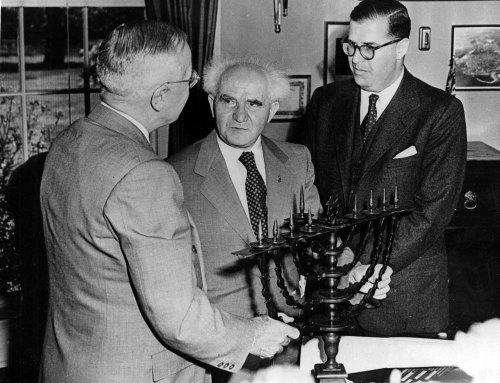
One Menorah, Many Generations
This menorah dates back to at least 1767, when it was donated to a synagogue in Buergel, Germany. The menorah was used in the synagogue until 1913, when it was found broken in pieces. A man by the name of Siegfried Guggenheim asked for the broken pieces and provided a replacement. The Guggenheim family restored the old menorah for their personal use, and brought it to the United States when they immigrated in the 1930s. Eventually, the menorah was acquired by the Jewish Museum in New York.
When Prime Minister Ben-Gurion visited the United States in 1951, he searched for a suitable gift to give to Harry S. Truman in light of the President’s recognition and support of the State of Israel. The Jewish Museum suggested the menorah, and Prime Minister Ben-Gurion presented it to Truman on his birthday, May 8, 1951. It is now among the gifts from heads of state at the Truman Presidential Library and Museum.
In 2008, the menorah that was given to Harry S. Truman from David Ben-Gurion returned to the White House to be lit in a Hanukkah ceremony. Clifton Truman Daniel, grandson of President Truman, and Yariv Ben-Eliezer, grandson of Prime Minister Ben-Guiron, participated in the lighting. The George W. Bush Administration borrowed the menorah from the Truman Library.
Happy Hanukkah!
Images:
Menorah presented to Harry S. Truman by Prime Minister David Ben-Gurion of Israel on 5/8/51.
David Ben-Gurion, Israeli Prime Minister, and Abba Eban, Israeli Ambassador to the United States, present Harry S. Truman with a menorah in the White House. 5/8/51.
Yariv Ben-Eliezer, grandson of David Ben-Gurion, and Clifton Truman Daniel,
grandson of Harry S. Truman, light the menorah for the annual White House Hanukkah Reception. 12/15/08.
#Hanukkah#happy hanukkah#History#Israel#Harry S. Truman#Presidents#Truman#David Ben-Gurion#White House#Menorah#May 8#December 15#Jewish Museum#Truman Library
240 notes
·
View notes
Text
Why Kansas City Is the Best Choice for Luxury Apartment Rental

Kansas City is the one of the most best and happening attractions of United States with lots of amusements, weekend and summer vacation places, art museums, performing art theaters, parks, zoos, cafe, restaurants and more. The city has thousands of renowned attractions that make it world's hottest shopping, dining and entertaining destination. The Country club plaza is the popular place in the city which was the first outdoor shopping, dining and entertainment district of United States.
The weather is suitable and makes it an awesome place to visit any time of year. It is the perfect place for the foodies, art, shopping and fun-loving people. You can feel the immense pleasure of jazz music in the evening sitting in a beautiful courtyard with dinner and drinks. The romantic carriage ride is a wonderful gift for the loving couples. The Nelson - Atkins Museum of Art is one of the most precious art center having unique collection of Egyptian sculptures more than 2000 Japanese artwork from the 10 century B.C.E. The free entrance and special exhibits make it a great deal.
The Kansas City Zoo is the major attraction for kids, where you can see animals from all the seven continents and travel the world. It covers nearly 200 acres of ground with more than 900 animals. The famous IMAX Theater is the situated next to it. The world best barbeques are the cultural proud of the city which are renowned for their dry rubbed meats covered with spicy sauces and cooked with great perfection. The City is popular known as the Home of Barbeques. In urban Kansas City there are more than 90 barbecues.
The largest farmer's market in Midwest is recognized for their various restaurants and cafe offering the fresh products, top quality sea food, meats and other specialty items. The abundant and fully interactive Science City or Union Station has famed Rail Exhibit planetarium shows, movies and other world's popular exhibits. The very appetizing meals are served in some of the great restaurants. Harry S. Truman Presidential Library has an outstanding collection of more than 30,000 presidential artifacts, motion pictures, photographs and political cartoon exhibit royalgreen.
The high-profile Riverboat Casinos of Kansas City is the great destination for hotels, spas, restaurants, lounges, concert venues, movie theaters and many more amusing recreational activities. The glorious 18th and Vine Jazz district has world-famous American Jazz Museum, Negro Leagues Baseball Museum and Gem Theater. The Liberty Memorial and the National WWI Museum have the historic memories of sacrificed soldiers which also serve as the leading educational institute and resource of WWI. The top-notch of the Liberty Memorial offers the most wonderful 360 views of the City. The Powell garden covers more than 900 acre botanical garden and blossom with attractive display of plants and flowers.
All these world-class attractions and destinations make Kansas City the most desirable place to live. Kansas City is the best place with various luxurious and sophisticated apartments with unlimited amenities like air conditioning, Wi-Fi or broadband internet access, business center on-site, cable, controlled and secure gate access, courtyard, club house, fitness centers, panoramic city views, carpets, fans, dishwasher, elevator, extra storage space, garbage disposal, parking, swimming pools, disability access, tennis court, and many more. Kansas City apartments for rent are available relatively at very affordable prices that ensure an ultra modern and stress free lifestyle. Kansas City apartment rental won't make any extra hole to the pocket and the lavish facilities and quality life offered feel like great deals.
2 notes
·
View notes
Photo
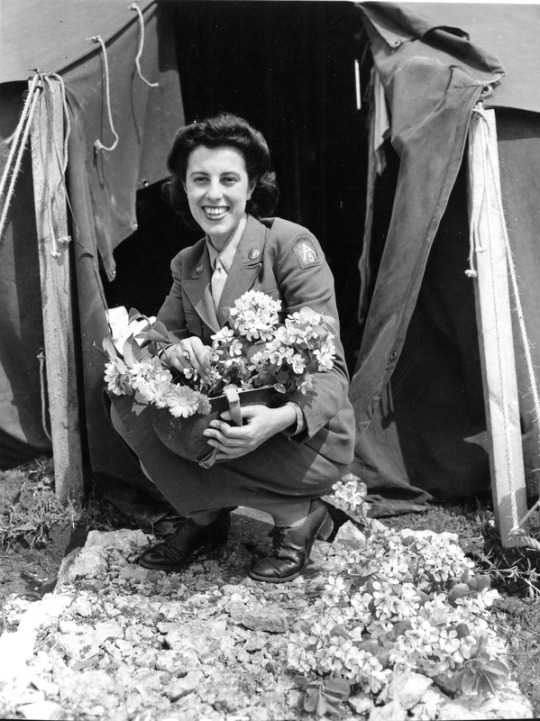
Women's Army Corps (WAC) Private Lucy Amber Uses Her Helmet To Hold Flowers
Description
WAC Private First Class Lucy Amber of Brooklyn, New York is using her helmet to hold flowers. She is a member of the 6669th WAC Headquarters Platoon, Fifth Army, stationed in San Marco Area, Italy.
Date(s)
April 11, 1944
Credit
United States Army Signal Corps
Harry S. Truman Library & Museum
#lots of great wac photos from the truman library!#historical#people#myupload*#photography#lucy amber#1940s#italy#wwii
12 notes
·
View notes
Text

Alvin Ailey born on January 5th 1931, in Rogers, Texas, at the height of the Great Depression in the violently racist and segregated south, during his youth Ailey was barred from interacting with mainstream society. Abandoned by his father when he was three months old, Ailey and his mother were forced to work in cotton fields and as domestics in white homes—the only employment available to them. As an escape, Ailey found refuge in the church, sneaking out at night to watch adults dance, and in writing a journal, a practice that he maintained his entire life. Even this could not shield him from a shiftless childhood spent moving from town to town as his mother sought employment, being abandoned with relatives whenever she took off on her own, or watching her get raped at the hands of a white man when he was five years old.
Looking for greater job prospects, Ailey’s mother departed for Los Angeles in 1941. He arrived a year later, enrolling at George Washington Carver Junior High School, and then graduating into Thomas Jefferson High School. In 1946 he had his first experience with concert dance when he saw the Katherine Dunham Dance Company and Ballet Russe de Monte Carlo perform at the Los Angeles Philharmonic Auditorium. This awakened an until then unknown spark of joy within him, though he did not become serious about dance until 1949 when his classmate and friend Carmen De Lavallade dragged him to the Melrose Avenue studio of Lester Horton.
Ailey studied a wide range of dance styles and techniques—from ballet to Native American inspired movement studies—at Horton’s school, which was one of the first racially integrated dance schools in the United States. Though Horton became his mentor, Ailey did not commit to dancing full-time; instead he pursued academic courses, studying romance languages and writing at UCLA. He continued these studies at San Francisco State in 1951. Living in San Francisco he met Maya Angelou, then known as Marguerite Johnson, with whom he formed a nightclub act called “Al and Rita”. Eventually, he returned to study dance with Horton in Los Angeles.
He joined Horton’s dance company in 1953, making his debut in Horton’s Revue Le Bal Caribe. Horton died suddenly that same year in November from a heart attack, leaving the company without leadership. In order to complete the organization’s pressing professional engagements, and because no one else was willing to, Ailey took over as artistic director and choreographer.
In 1954 De Lavallade and Ailey were recruited by Herbert Ross to join the Broadway show, House of Flowers. Ross had been hired to replace George Balanchine as the show’s choreographer and he wanted to use the pair, who had become known as a famous dance team in Los Angeles, as featured dancers. The show’s book was written and adapted by Truman Capote from one of his novellas with music from Harold Arlen and starred Pearl Bailey and Diahann Carroll. Ailey and De Lavallade met Geoffrey Holder, who performed alongside them in the chorus, during the production. Holder married De Lavallade and became a life-long artistic collaborator with Ailey. After House of Flowers closed, Ailey appeared in Harry Belafonte’s touring revue Sing, Man, Sing with Mary Hinkson as his dance partner, and the 1957 Broadway musical Jamaica, which starred Lena Horne and Ricardo Montalbán. Drawn to dance, but unable to find a choreographer whose work fulfilled him, Ailey started gathering dancers to perform his own unique vision of dance.
Alvin Ailey, a.k.a. Alvin Ailey Jr., founded the Alvin Ailey American Dance Theater (AAADT). He created AAADT and its affiliated Ailey School as havens for nurturing black artists and expressing the universality of the African-American experience through dance. His work fused theatre, modern dance, ballet, and jazz with black vernacular, creating hope-fueled choreography that continues to spread global awareness of black life in America. Ailey’s choreographic masterpiece Revelations is recognized as one of the most popular and most performed ballets in the world. In this work he blended primitive, modern and jazz elements of dance with a concern for black rural America. On July 15, 2008, the United States Congress passed a resolution designating AAADT a “vital American cultural ambassador to the World.” That same year, in recognition of AAADT’s 50th anniversary, then Mayor Michael Bloomberg declared December 4 “Alvin Ailey Day” in New York City while then Governor David Paterson honoured the organization on behalf of New York State.
Ailey loathed the label “black choreographer” and preferred being known simply as a choreographer. He was notoriously private about his life. Though gay, he kept his romantic affairs in the closet. Following the death of his friend Joyce Trisler, a failed relationship, and bouts of heavy drinking and cocaine use, Ailey suffered a mental breakdown in 1980. He was diagnosed as manic depressive, known today as bipolar disorder. During his rehabilitation, Judith Jamison served as co-director of AAADT.
Ailey died from an AIDS related illness on December 1, 1989, at the age of 58. He asked his doctor to announce that his death was caused by terminal blood dyscrasia in order to shield his mother from the stigma associated with HIV/AIDS.
Choreography
Cinco Latinos, Alvin Ailey American Dance Theatre, Kaufmann Concert Hall, New York City, 1958.
Blues Suite (also see below), Alvin Ailey American Dance Theatre, Kaufmann Concert Hall, 1958.
Revelations, Alvin Ailey American Dance Theatre, Kaufmann ConcertHall, 1960
Three for Now, Alvin Ailey American Dance Theatre, Clark Center, New York City, 1960.
Knoxville: Summer of 1915, Alvin Ailey American Dance Theatre, Clark Center, 1960.
(With Carmen De Lavallade) Roots of the Blues, Lewisohn Stadium, New York City, 1961.
Hermit Songs, Alvin Ailey American Dance Theatre, Library of Congress, Washington, D.C., 1963.
Ariadne, Harkness Ballet, Opera Comique, Paris, 1965.
Macumba, Harkness Ballet, Gran Teatro del Liceo, Barcelona, Spain,1966, then produced as Yemanja, Chicago Opera House, 1967.
Quintet, Alvin Ailey American Dance Theatre, Church Hill Theatre, Edinburgh Festival, Scotland, 1968, then Billy Rose Theatre, New York City, 1969.
Masekela Langage, Alvin Ailey American Dance Theatre, American Dance Festival, New London, Connecticut, 1969, then Brooklyn Academy of Music, New York City, 1969.
Streams, Alvin Ailey American Dance Theatre, Brooklyn Academy of Music, 1970.
Gymnopedies, Alvin Ailey American Dance Theatre, Brooklyn Academy of Music, 1970.
The River, American Ballet Theatre, New York State Theater, 1970.
Flowers, Alvin Ailey American Dance Theatre, ANTA Theatre, 1971.
Myth, Alvin Ailey American Dance Theatre, New York City Center, 1971.
Choral Dances, Alvin Ailey American Dance Theatre, New York City Center, 1971.
Cry, Alvin Ailey American Dance Theatre, New York City Center, 1971.
Mingus Dances, Robert Joffrey Company, New York City Center, 1971.
Mary Lou’s Mass, Alvin Ailey American Dance Theatre, New York City Center, 1971.
Song for You, Alvin Ailey American Dance Theatre, New York City Center, 1972.
The Lark Ascending, Alvin Ailey American Dance Theatre, New York City Center, 1972.
Love Songs, Alvin Ailey City Center Dance Theater, New York City Center, 1972.
Shaken Angels, 10th New York Dance Festival, Delacorte Theatre, New York City, 1972.
Sea Change, American Ballet Theatre, Kennedy Center Opera House, Washington, D.C., 1972, then New York City Center, 1973.
Hidden Rites, Alvin Ailey City Center Dance Theater, New York City Center, 1973.
Archipelago, 1971,
The Mooche, 1975,
Night Creature, 1975,
Pas de “Duke”, 1976,
Memoria, 1979,
Phases, 1980
Landscape, 1981.
Stage
Acting and dancing
(Broadway debut) House of Flowers, Alvin Theatre, New York City, 1954 – Actor and dancer.
The Carefree Tree, 1955 – Actor and dancer.
Sing, Man, Sing, 1956 – Actor and dancer.
Show Boat, Marine Theatre, Jones Beach, New York, 1957 – Actor and dancer.
Jamaica, Imperial Theatre, New York City, 1957 – Actor and lead dance.
Call Me By My Rightful Name, One Sheridan Square Theatre, 1961 – Paul.
Ding Dong Bell, Westport Country Playhouse, 1961 – Negro Political Leader.
Blackstone Boulevard, Talking to You, produced as double-bill in 2 by Saroyan, East End Theatre, New York City, 1961-62.
Tiger, Tiger, Burning Bright, Booth Theatre, 1962 – Clarence Morris.
Stage choreography
Carmen Jones, Theatre in the Park, 1959.
Jamaica, Music Circus, Lambertville, New Jersey, 1959.
Dark of the Moon, Lenox Hill Playhouse, 1960.
(And director) African Holiday (musical), Apollo Theatre, New York City, 1960, then produced at Howard Theatre, Washington, D.C., 1960.
Feast of Ashes (ballet), Robert Joffrey Company, Teatro San Carlos, Lisbon, Portugal, 1962, then produced at New York City Center, 1971.
Antony and Cleopatra (opera), Metropolitan Opera House, Lincoln Center, New York City, 1966.
La Strada, first produced at Lunt-Fontanne Theatre, 1969.
Leonard Bernstein’s Mass, Metropolitan Opera House, 1972, then John F. Kennedy Center for the Performing Arts, Washington, D.C., and Philadelphia Academy of Music, both 1972.
Carmen, Metropolitan Opera, 1972.
Choreographed ballet, Lord Byron (opera; also see below), Juilliard School of Music, New York City, 1972.
Four Saints in Three Acts, Piccolo Met, New York City, 1973.
Director
(With William Hairston) Jerico-Jim Crow, The Sanctuary, New York City, 1964, then Greenwich Mews Theatre, 1968.
In 1968 Ailey was awarded the Guggenheim Fellowship for Creative Arts, US & Canada. In 1977 he received the Spingarn Medal from the NAACP. He received the Kennedy Center Honors in 1988, was inducted into the National Museum of Dance and Hall of Fame in 1992, inducted into the Legacy Walk in 2012, and posthumously received the Presidential Medal of Freedom from President Barack Obama in 2014.
In August 2019, Ailey was one of the honorees inducted in the Rainbow Honor Walk, a walk of fame in San Francisco’s Castro neighborhood noting LGBTQ people who have “made significant contributions in their fields.”
A crater on Mercury was named in his honor in 2012.
Daily inspiration. Discover more photos at http://justforbooks.tumblr.com
7 notes
·
View notes
Photo

In 1947, Harry S. Truman presided over the first live turkey presentation by the Poultry and Egg National Board. The event became an annual White House tradition.
Initially the presentation birds were intended for the Thanksgiving meal, like this turkey presented to President Johnson in 1967.
In November 14, 1989, President George H. W. Bush officially “granted a Presidential pardon” to a turkey, marking the beginning of a new annual Thanksgiving tradition.
Image: Senator Everett Dirksen and representatives from the poultry industry and farm organizations present a turkey to President Johnson in the Fish Room of the White House. Lyndon Baines Johnson Library and Museum
73 notes
·
View notes
Photo
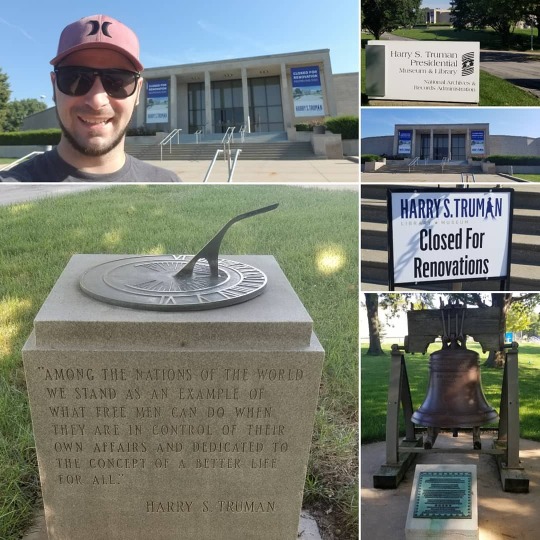
Truman Presidential Library & Museum, Independence, Missouri - Adding another presidential library and museum to my list! This time, it was for Harry S. Truman, 33rd president of the United States. Sadly, it was closed for renovations, but we still got to explore the monuments and memorials around the building. The land on which the museum is situated was donated by Truman's hometown of Independence and was dedicated on July 6,1957. While still alive, the former president actually took part in daily activities here, greeting guests and training museum docents. He spent so much time here that he had his own office! Upon his death in 1972, he was buried here in the courtyard. Ten years later, his wife Bess was laid to rest beside him. #MikeDoesHistory #history #education #travel #roadtrip #learn #adventure #explore #discover #like #instagram #museum #President #POTUS #politician #American #Independence #library #donate #office #burial #hometown #monument #memorial #subscribe #instagram #historygram #Truman #visit #selfie (at Harry S. Truman Library & Museum) https://www.instagram.com/p/B4SZ2LHDFey/?igshid=y6913pymcjv9
#mikedoeshistory#history#education#travel#roadtrip#learn#adventure#explore#discover#like#instagram#museum#president#potus#politician#american#independence#library#donate#office#burial#hometown#monument#memorial#subscribe#historygram#truman#visit#selfie
1 note
·
View note
Photo
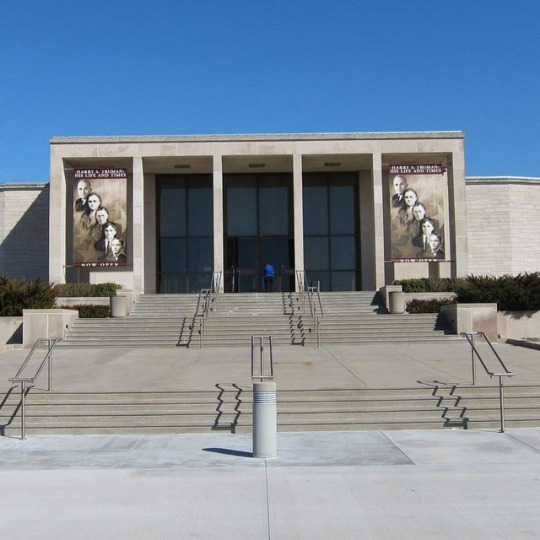
The Harry Truman Library and Museum, when you get where you are going look around, my sister lived only a couple miles from here and did not know it. My sister is an expert in snowballs ask her about how they don't have the right kind of snow at this place to make a snowball. (Wack). #coalnation (at Harry S. Truman Library & Museum) https://www.instagram.com/p/B3xFgoeJe0G/?igshid=1e8o04ifjpx6a
1 note
·
View note
Text

Harry S. Truman Library and Museum, Independence, MO, USA. February 2nd, 2019.
24 notes
·
View notes
Text
Show Notes 107 "Implosion"
Evil is afoot, Agents.
As always, you can click on this link or by clicking play on the embedded player below to listen to this week’s episode while reading the show notes.
Also, don’t forget that you can support us on Patreon!
This week's Writer Appreciation Corner focuses on Bob Goodman, a true asset to the Warehouse 13 writing staff. We love Bob Goodman and even featured a quote from his io9 article in our "Bonus 01 - Podcast 13 Season 1 Trailer,” linked here and embedded below.
You can follow him on Twitter as @b0bg00dman.
The episode starts with Pete imitating a dubbed Japanese samurai movie. This week's episode dealt a lot with a lot of ~heavy themes~ related to Japan and WWII, and interestingly those themes tie directly into the media history of samurai cinema. Pete was almost certainly imitating the action-packed samurai cinema films that were popular after WWII. And, in fact, most samurai cinema was set during the Tokugawa/Edo Period--exactly when the Honjō Masamune was crafted. You can find a list of some seminal works of Samurai Cinema from The Criterion Collection.
It's interesting that the episode focused on a Masamune being given as a gift to a US president after WWII, because a Masamune was actually given to President Harry S. Truman after WWII and currently resides in the Harry S. Truman Presidential Library and Museum. That's a pretty direct allegory to a sword being given to Woodrow Wilson and residing in the Woodrow Wilson Museum of Peace.
Incidentally, there is no actual Woodrow Wilson Museum of Peace, but there is a Woodrow Wilson Presidential Library and Museum, and it is (at least partially) a house!
And since the episode got to the Honjō Masamune pretty quickly and led to an early introduction of our expert in the podcast, let's give her the same treatment here in the show notes! We are so grateful and honored to have had the highly illuminating Dr. Nyri Bakkalian as our Artifact Expert this week. She shed so much light onto a subject that I have just…no other knowledge of whatsoever. It was fascinating to hear all she had to say about the Honjō Masamune and about Japanese swords post WWII more broadly. You can find her on Twitter as @riversidewings, check out her blog, or support her on her Patreon for more information.
Dr. Nyri Bakkalian shared a cringe-worthy story of someone who stripped a samurai sword to the tang. If you know nothing about swords (like me) then you probably didn't know what a tang was--or that there are so many more parts of a blade than the hilt, tsuba, and that long stabby bit. For my fellow sword novices, here's some info on the anatomy of a sword. Here's some information specifically on Japanese swords. And here's some information specifically on tsubas and other Japanese sword mountings.
But guess what?!
Dr. Bakkalian was kind enough to give us even more information after Miranda's interview. She sent us a link to a Japanese resource that discusses the real Honjō Masamune--and that even includes a diagram of the sword itself. Dr. Bakkalian added that "the sword was appraised many times, but it was designated a National Treasure of Japan in 1939, so we're fortunate that we at least have a paper trail if not the blade itself."
While I don't know much about swords, I do know a bit about kitchen knives. And what I know about kitchen knives ties in--very slightly--with the history of swords. Specifically, the layering technique of forging Japanese steel blades. Here's a bit more information on how Japanese kitchen knives are made and how that ties into the history of sword-making in Japan. Not that anyone asked, but I'm a big fan of my hybrid knife set that has a Japanese steel blade but a piece of thick metal that extends all the way down through the hilt like a German blade. The knives have a nice thin, sharp edge like a Japanese blade but a comfortingly weighty, solid handle that makes me feel more in control as I cook. I've included pictures of them, because I love them and this is the closest I can come to being useful about anything related to blades.
This episode dealt a lot with the frustration that can come from poor communication between friends and coworkers. This is something that Artie struggles with a lot. Here is an interesting blog post for any managers or team leaders out there looking to foster better communication in their workplace.
In the stakeout scene in the parking lot of the Japanese Embassy, Pete makes a joke about how the goggles make him look like Kermit the Frog. I couldn't find a pic or gif of him in the goggles, but here's a pic of Kermit.
As we get further into the series of Warehouse 13, we're starting to encounter more and more artifacts per episode, which means that we may not have experts on to discuss every single artifact that an episode references or features. That said, we love this fan wiki as a resource to look into the artifacts that don't get as much airtime on Warehouse 13 or on our podcast.
In this episode, we don't spend a lot of time on it, but Artie uses a 14th Century Firework called an "Ice Flower" that mesmerizes onlookers by triggering a feedback loop in their optic nerve. You can find out more about mesmerism in our show notes for 103 "Magnetism." The fan wiki points out that the firework resembles a type of firework known as a Catherine wheel firework. Here's some more information about the history of fireworks.
In the hotel room with Artie, Pete, and Myka, Myka demands that Artie tell them exactly what the sword does. We learn that the sword turns the bearer invisible but splitting light in half. The bending and manipulation of light to essentially mimic invisibility is actually a thing that scientists are researching. There are lots of techniques they try, and you can learn more about them here.
In this same scene, we got another great detail from the brilliant art department on this show. As Artie is explaining the history of the Honjō Masamune, he pulls out a Japanese handscroll. Japanese illustrated handscrolls are a beautiful and intricate form of visual storytelling media and you can read more about them here. Personally, I learned about them from the video lecture series from Sunday at the Met entitled "Storytelling in Japanese Art." You can click the previous link or click play on the embedded video below to watch that lecture series.
You can find more lectures about art and history from The Metropolitan Museum of art on the museum's website or more directly, from its YouTube channel. I've found some truly amazing information there.
We made a reference to Kluger getting "dusted" (RIP Kluger). That was, you guessed it, a Buffy the Vampire Slayer reference.
Miranda referenced using the Oxford English Dictionary to look up the origin of the word "kabosh." The OED, as it is affectionately called is an amazing resource at whom's alter Miranda and I both worship. It's so much more than a dictionary. It gives the history and first use of every word you can imagine.
You can gain access to it with your library card number, so please: support your local library. Go and sign up for a card, so you can access this awesome resource.
Now that you have a library card (I'm assuming you dropped whatever you were doing to go support your local library and get a library card), you can now check out the books where the phrase "to put a kabosh on" were first used. The first was Sketches by Boz by Charles Dickens and the second was The Wheels of Chance by H.G. Wells.
It is taking literally everything in my power not to post a spoilery gif of H.G. wells right now, but I'm committed to keeping major plot developments out of the show notes until we discuss them on the podcast, so instead here's a picture of me right now trying not to spoil things.
We also discuss how Artie's file said he was suspected of espionage but was actually arrested for treason. Small fact check, but espionage and treason are different crimes.
Outside the Wilson Museum, Pete and Myka have one of their patented heart-to-heart and Myka unintentionally reveals--much to Pete's delight--that she is a fan of Star Trek: The Original Series. Specifically, she and Pete discuss the trope of "red shirts."
We talked about how the orange vs. purple Tesla reminded us of lightsabers in Star Wars and Priori Incantatem in Harry Potter.
Miranda gave a Mini-Actor Spotlight on the actor who portrays Mrs. Frederic's bodyguard, Jung-Yul Kim.
Meanwhile, our main Actor Spotlight of the week focused on James MacPherson himself, Roger Rees. His IMDB is incredibly impressive, but his credits extend far beyond his work on the big and small screen.
Miranda recognized him from his turn as Lord John Marbury in The West Wing.
We also gave a shout out to Rees' husband, Rick Elice, an accomplished writer and actor in his own right. Sadly, Roger Rees passed from brain cancer in 2015. He was a powerful and talented actor who left an enduring mark on Warehouse 13. Rest in Pease, sir.
We referenced this hilarious scene with Pete and Myka's gesture-based discussion about needing to shoot unsuspecting Secret Service Agents with the Tesla...
…and how it reminded us of Spike knocking over the "Welcome to Sunnydale" sign every time he entered and left town in Buffy the Vampire Slayer. (Another reference #TakeAShot)
We also take a moment to appreciate the importance of Leena to the Warehouse. She's great, and we want everyone to remember that she's great.
We also talk about how Artie's unwillingness to address the source of his closed-off nature ends up putting Pete and Myka in danger and making Myka very upset. She says that Artie needs to address his emotions instead of allowing his emotional scars to hurt those around him. Miranda and I support mental wellness and therapy. Please see our show notes for 103 Magnetism for a list of crisis resources.
The episode ended with a couple of quotes from the Talmud. You can learn more about Jewish Sacred Texts here. I haven't personally used this resource so I can't very translations or commentary or anything, but we always link to books we reference in the podcast--so, if you want, you can read the Talmud online here.
That's all for this week.
See you next time, Agents.
#wh13#warehouse13#Warehouse 13#107 Implosion#podcast 13#pc13#podcast13#roger rees#buffy the vampire slayer#btvs#james macpherson#bob goodman#daniel dickinson#Dr. Nyri Bakkalian#communication#talmud#jumblr
7 notes
·
View notes